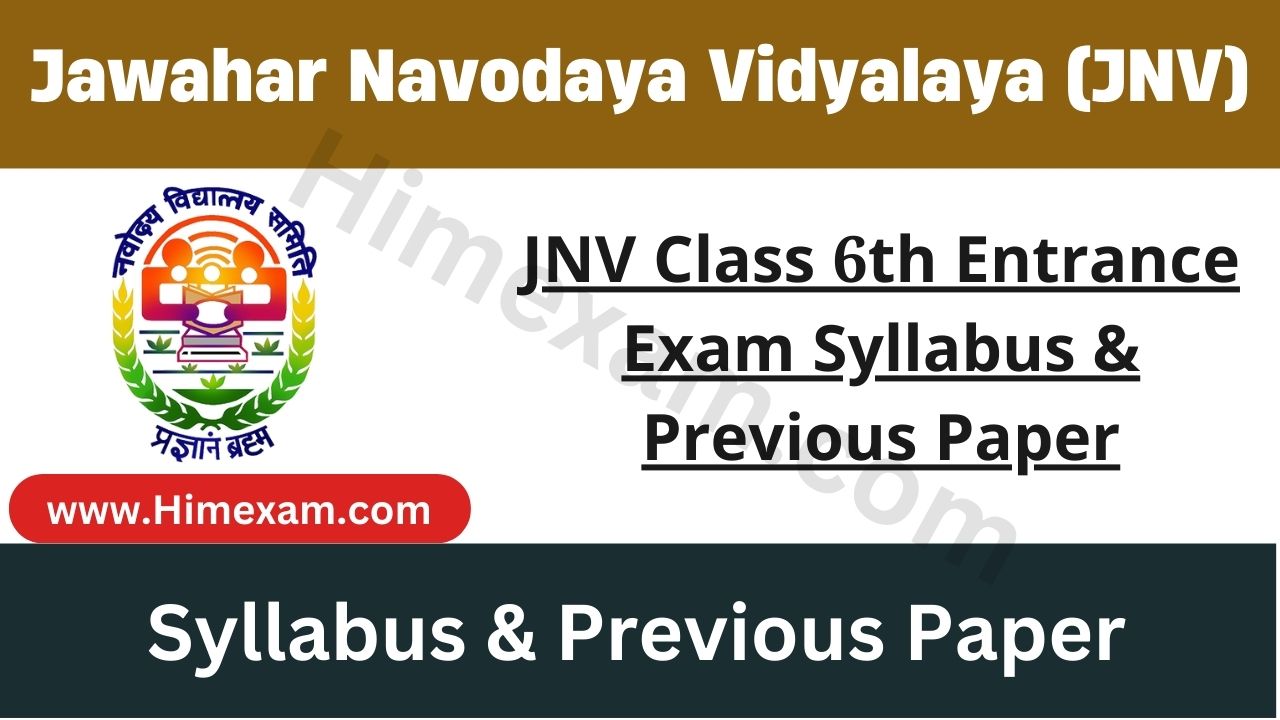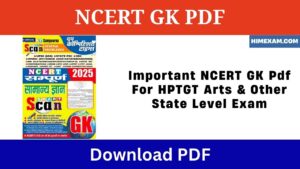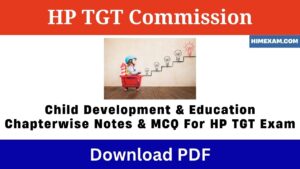Table of Contents
ToggleJNV Class 6th Exam Syllabus & Previous Paper
Jawahar Navodaya Vidyalaya (JNV) Class 6 Entrance Exam is a national level competitive examination aimed at providing quality education to bright students from rural areas. The exam is conducted by Navodaya Vidyalaya Samiti (NVS), an organisation under the Ministry of Human Resource Development, Government of India. The exam pattern is designed to test the mental ability, mathematical aptitude, and language comprehension of the students.
Also Read :- RRB NTPC Syllabus & Previous Paper
Jawahar Navodaya Vidalaya Class 6th Entrance Exam Syllabus & Previous Paper
| Organization | Navodaya Vidyalaya Samiti (NVS) |
| Class | 6th |
| Paper Mode | Offline |
| Total Question | 80 |
| Total Marks | 100 |
JNV Class 6th Entrance Exam Pattern
The question paper of the exam is mainly divided into three parts. The first part is the Mental Ability Test, which tests the logical and analytical thinking of the students. This section consists of 40 questions, which include questions like picture based questions, pattern recognition, series completion, mirror image, and analogy. The aim of this section is to test the mental agility and problem solving ability of the students, which is an important part of their overall mental development.
The second part is the Arithmetic Test, which consists of 20 questions. It covers basic mathematical problems such as number systems, addition, subtraction, multiplication, division, time and distance, geometry, and understanding of data. This section evaluates the numerical and mathematical thinking of students, which helps in solving problems of daily life.
The third and final part is the Language Test, which also consists of 20 questions. This section tests the language comprehension, reading ability, and grammatical knowledge of students. Usually, students are given the option to solve questions in their mother tongue or in English. This section includes questions based on reading passages, answering questions on sentence structure, meaning, synonyms, antonyms, and other aspects of grammar.
| Topic | Question | Marks | Time |
|---|---|---|---|
| Mental Ability Test | 40 | 50 | 60 Min. |
| Arithmetic | 20 | 25 | 30 Min |
| Language Test | 20 | 25 | 30 Min |
| Total | 80 | 100 | 120 |
JNV Class 6th Entrance Exam Syllabus
| Subject | Topics |
|---|---|
| Mental Ability Test | Figure Analogy: It contains questions that identify the relationship between the pictures. Students have to identify the pattern or relationship of the given pictures and choose the correct option. Figure Classification: In this type of questions, students have to identify the odd picture from a group of different pictures. Figure Series Completion: In this, students have to identify the next picture in a series. The correct answer has to be given by understanding the pattern in the series. Mirror Images: Students have to identify the mirror images of the given pictures. These questions are based on the reflection seen in the mirror. Water Images: In these questions, students have to identify the image seen in the water (water reflection). Punching Hole (Pattern Folding and Unfolding): In this, students have to understand the process of making holes or folding on the paper and identify the pattern formed at the end. Embedded Figures: In this type of questions, students have to identify a small figure hidden in a larger figure. Pattern Folding and Unfolding: Students have to understand what pattern will be formed when the paper is folded or unfolded. Cubes and Dice: Questions in this section are related to the different orientations and numbering of cubes or dice. Students are tested for their ability to view the cube or dice from different orientations. Analogy: In this, students have to identify the relationship between words, numbers or pictures in the questions and choose the correct option using that relationship. Pattern Completion & Figure Matrix: In this section, students have to complete the pattern based on the given figures or choose the correct option from the given matrix. Serial Order: In this section students have to understand the given sequence and identify the next element in that sequence. |
| Arithmetic | Numbers: Understanding of numbers, place value of digits, identification of large and small numbers, comparison of numbers. Whole Numbers: Definition, properties of integers and basic mathematical operations with them such as addition, subtraction, multiplication, and division. Fractions: Definition, types of fractions (like fractions, unequal fractions), addition, subtraction, multiplication, and division of fractions. Decimals: Understanding of decimals, addition, subtraction, multiplication, and division of decimal numbers. LCM and HCF: Methods of finding LCM and HCF, factorization method and division method. Average: Concept of average, method of finding average, and problems related to average. Percentage: Concept of percentage, conversion of percentage into fraction and decimal and different types of percentage related problems. Simplification: Simplifying mathematical expressions, use of brackets (circle, square, and curly). Ratio and Proportion: Concept of ratio, calculation of ratio of two or more quantities, identification of proportion and solving problems. Time and Distance: Problems related to time and distance, calculation of speed, relation of time, distance, and speed. Time and Work: Speed of work, time taken by different persons to complete a work, calculation of time taken to do a joint work. Measurement: Standard measurement units of length, mass, and capacity, conversion of units. Geometry: Basic geometric shapes (triangle, quadrilateral, circle etc.), calculation of area and perimeter. Arithmetic Word Problems: Daily life problems based on all the above topics. Tables and Charts (Data Handling): Picture of data, use of tables and charts, reading and interpretation of simple graphs. Mensuration: Area and perimeter of simple geometrical figures like rectangle, square, triangle. |
| Language Test | Reading Comprehension: A short paragraph is given based on which questions are asked. Students have to read the paragraph and answer correctly. It tests their reading comprehension and ability to extract information from the text. Vocabulary: Meanings of words, synonyms, antonyms, synonyms, and correct usage of words. Appropriate selection of words and their use at the right place in sentences. Grammar: Noun, pronoun, verb, adjective, indeclinable, and adverb. Sentence structure, types of sentences, and identification of phrases. Tenses, gender, number, and case. Samaas, prefixes, suffixes, idioms, and proverbs. Sentence Formation: Composition of sentences, identification of correct order of sentences, and correcting incorrect phrases. Correct and Incorrect Usage: Identifying and correcting spelling errors. Use of correct grammar and spelling. Fill in the Blanks: Filling in the blanks in sentences with the correct word or phrase. Synonyms and Antonyms: Identifying words with similar and opposite meanings. Idioms and Phrases: Meaning of common idioms and proverbs and their use in sentences. Word Formation: Making new words by adding prefixes and suffixes. Homophones and Homonyms: Identifying words with similar sounds and their correct use. Jumbled Sentences: Putting jumbled sentences in the correct order so that their meaning is correct. Punctuation: Correct use of punctuation marks like full stop, interrogative, comma, etc. |
- The total time of the exam is two hours and the exam is conducted on OMR sheet.
- There are a total of 80 questions in the exam
- The question paper is of Multiple Choice Questions type, in which four options are given and students have to choose the correct answer.
JNV Class 6th Entrance Exam Syllabus & Previous Paper
The level of this Jawahar Navodaya Vidyalaya entrance exam is suitable for class 5 students, and no specific syllabus is followed. This exam is designed to provide equal opportunities to students from rural backgrounds to showcase their academic potential. Students who clear the exam get admission in Jawahar Navodaya Vidyalaya, where they are provided free residential education. Thus, JNV 6th class entrance exam not only tests the academic aptitude of the students but also lays the foundation for their bright future.
| JNV 6th Class Entrance Paper 2017,2018,2019 & 2020 | CLICK HERE |
| JNV 6th Class Entrance Paper 2021 | CLICK HERE |
| JNV 6th Class Entrance Paper 2025 | CLICK HERE |
FAQ Navodaya Vidyalaya Class 6th Entrance Exam Syllabus
Ans: There are three main subjects included in the entrance exam: Mental Ability Test Arithmetic Test Language Test
Answer: Students can appear for the exam in their mother tongue or any other regional language as prescribed by Navodaya Vidyalaya Samiti.
हेलो दोस्तों ,आपका हमारी वेबसाइट Himexam.com पर स्वागत है। जैसा की आपको पता है हमारी वेबसाइट Himexam.com आपको समय-समय पर सभी HP Govt Jobs & All India Govt Jobs की Notifications प्रदान करवाती है। साथ ही साथ Himachal Pradesh Exam Previous Paper और Himachal Pradesh GK ,Himachal Pradesh & National +International Current Affairs के सभी नोट्स मुफ्त उपलब्ध करवाते है। हमारी वेबसाइट के अलग अलग प्लेटफार्म पर pages & Group बने है जैसे की facebook ,Telegram और Instagram .. अगर आप हिमाचल के किसी भी पेपर की तैयारी कर रहे हो तो जल्दी से इन groups के साथ जुड़ जाएं इनके लिंक नीचे table में दिए गए है।
Join Us:-
| Like Our Facebook Page | Click here |
| Join Us oN Telegram | Click here |
| Join Us On Instagram | Click Here |








